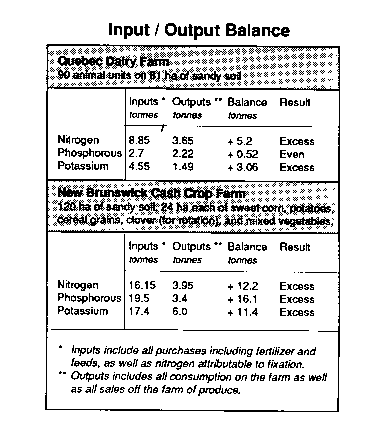
Sustainable Farming Index | Virtual Library | Magazine Rack
Search
| Ecological Solutions Roundtable
by Hugh Maynard
"You have no girlfriend because you don't wear deodorant, or you have a headache because you don't take aspirin," cites Denis LaFrance as examples of what he calls 'linear' thinking, a process pounded into the mind by a barrage of commercial messages ten minutes out of every hour. In agriculture, this is transformed by farmers into "there are weeds in the fields because of a lack of herbicide."
LaFrance, Director of the Centre de développement d'agrobiologie du QuŽbec, was the opening speaker at the 12th annual Organic Agriculture Conference, held at the end of January on the campus of the University of Guelph.
He used these and similar examples to get his point across about the need for farmers to adopt a "whole farm system." The major problem, LaFrance believes, is that too much of what farmers do is as a result of commercial advice - 85% according to him - and there needs to be a change in outlook, one that is long-term and global.
The straw bale approach is the starting point preferred by LaFrance. "Sit on the bale and observe," he said, and by posing questions the solutions will come. Sometimes it's a product, but often it's not." He intimates that it's surprising what can be seen from this vantage point:
¥ by examining manure, a farmer can see what grains are not being digested properly, perhaps requiring an adjustment in feeding practices.
¥ use of pasture in a dairy operation can save up to $10,000 in feed costs, as well keeping cows in better health.
¥ corn stalks can make up to one half of the nitrogen in the soil and their residual effect should be taken into account when determining fertilizer needs.
LaFrance has himself made some observations about the development of agricultural systems from working with farmers. He says that the biggest challenge is for farmers to learn how to manage approximations.
"Everyone wants to know exactly how much fertilizer to apply, plus 20% extra for safety, which, when you think about it, is 20% extra for weed growth," LaFrance said. He notes that farmers can manage approximations more precisely by conducting small scale trials with new techniques or products on plots, where there will be slow implementation and no major risk.
An examination of the net balance between inputs and outputs is another important reference for implementing a whole systems approach to farming. As an example, LaFrance has noted that organic dairy farms appear to use lower quantities of feed as the cows waste less because of the higher quality: "What's the point of fertilizing fields if one third of the hay is put into the manure pile because cows won't eat it?"
An analysis of the total nitrogen, phosphorous and potassium used in the farm operation is a good indicator (see tables with examples) of whether a linear or a whole system of management is in place, as well as the hidden costs of purchased inputs that end up polluting instead of being productive. A truck load of purchased 40% protein feed is equal to about a half truck load of fertilizer, according to LaFrance, because much of it passes right through the livestock as manure. But it's an expensive and inefficient way to apply fertilizer.
LaFrance says that such an analysis helps to paint a picture of the consequences of the farm's activities but should not be used as an absolute. Even still, if (conservative) current values are applied to the excess of N, P, K inputs purchased by the New Brunswick cash crop farm, LaFrance believes that the farmer would have $25,000 annually to direct to other resources on the farm without affecting production; at the very least, the farm could significantly reduce the amount of nutrients that end up polluting waterways.
"The worst thing about pollution from farms is that every kilo of pollutant has first been paid for by farmers," LaFrance emphasizes. He cites the Yamaska River, located south- east of Montreal, as a prime example. Notorious for its pollution by an over-load of hog farms along its banks, the Yamaska absorbs 14,000 tonnes of nitrogen from agricultural run-off annually. LaFrance estimates that the 4,000 farms in the river basin are watching $12.5 million, or $3,000 per farm, wash away each year.
LaFrance concluded by saying that any changes in society start with education, farmers being no exception: "Those that succeed are the ones who invest in good solid training."

Copyright © 1993 REAP Canada
Reprinted with permission. All rights reserved.
Info Request | Services | Become EAP Member | Site Map
Give us your comments about the EAP site
Ecological Agriculture Projects, McGill University (Macdonald
Campus),
Ste-Anne-de-Bellevue, QC, H9X 3V9 Canada
Telephone:
(514)-398-7771
Fax:
(514)-398-7621
Email: info@eap.mcgill.ca
To report problems or otherwise comment on the structure of this site, send mail to the Webmaster